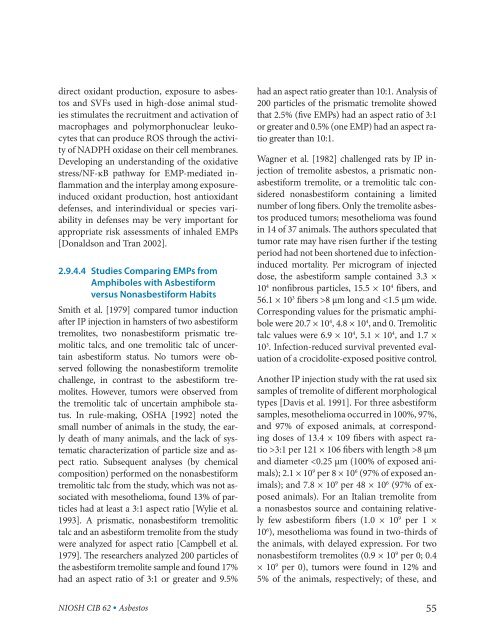Asbestos Fibers and Other Elongate Mineral Particles: State of the ...
Asbestos Fibers and Other Elongate Mineral Particles: State of the ...
Asbestos Fibers and Other Elongate Mineral Particles: State of the ...
- No tags were found...
Create successful ePaper yourself
Turn your PDF publications into a flip-book with our unique Google optimized e-Paper software.
direct oxidant production, exposure to asbestos<br />
<strong>and</strong> SVFs used in high-dose animal studies<br />
stimulates <strong>the</strong> recruitment <strong>and</strong> activation <strong>of</strong><br />
macrophages <strong>and</strong> polymorphonuclear leukocytes<br />
that can produce ROS through <strong>the</strong> activity<br />
<strong>of</strong> NADPH oxidase on <strong>the</strong>ir cell membranes.<br />
Developing an underst<strong>and</strong>ing <strong>of</strong> <strong>the</strong> oxidative<br />
stress/NF-ĸB pathway for EMP-mediated inflammation<br />
<strong>and</strong> <strong>the</strong> interplay among exposureinduced<br />
oxidant production, host antioxidant<br />
defenses, <strong>and</strong> interindividual or species variability<br />
in defenses may be very important for<br />
appropriate risk assessments <strong>of</strong> inhaled EMPs<br />
[Donaldson <strong>and</strong> Tran 2002].<br />
2.9.4.4 Studies Comparing EMPs from<br />
Amphiboles with Asbestiform<br />
versus Nonasbestiform Habits<br />
Smith et al. [1979] compared tumor induction<br />
after IP injection in hamsters <strong>of</strong> two asbestiform<br />
tremolites, two nonasbestiform prismatic tremo<br />
litic talcs, <strong>and</strong> one tremolitic talc <strong>of</strong> uncertain<br />
asbestiform status. No tumors were observed<br />
following <strong>the</strong> nonasbestiform tremolite<br />
challenge, in contrast to <strong>the</strong> asbestiform tremo<br />
lites. However, tumors were observed from<br />
<strong>the</strong> tremolitic talc <strong>of</strong> uncertain amphibole status.<br />
In rule-making, OSHA [1992] noted <strong>the</strong><br />
small number <strong>of</strong> animals in <strong>the</strong> study, <strong>the</strong> early<br />
death <strong>of</strong> many animals, <strong>and</strong> <strong>the</strong> lack <strong>of</strong> systematic<br />
characterization <strong>of</strong> particle size <strong>and</strong> aspect<br />
ratio. Subsequent analyses (by chemical<br />
composition) performed on <strong>the</strong> nonasbestiform<br />
tremolitic talc from <strong>the</strong> study, which was not associated<br />
with meso<strong>the</strong>lioma, found 13% <strong>of</strong> particles<br />
had at least a 3:1 aspect ratio [Wylie et al.<br />
1993]. A prismatic, nonasbestiform tremolitic<br />
talc <strong>and</strong> an asbestiform tremolite from <strong>the</strong> study<br />
were analyzed for aspect ratio [Campbell et al.<br />
1979]. The researchers analyzed 200 particles <strong>of</strong><br />
<strong>the</strong> asbestiform tremolite sample <strong>and</strong> found 17%<br />
had an aspect ratio <strong>of</strong> 3:1 or greater <strong>and</strong> 9.5%<br />
NIOSH CIB 62 • <strong>Asbestos</strong><br />
had an aspect ratio greater than 10:1. Analysis <strong>of</strong><br />
200 particles <strong>of</strong> <strong>the</strong> prismatic tremolite showed<br />
that 2.5% (five EMPs) had an aspect ratio <strong>of</strong> 3:1<br />
or greater <strong>and</strong> 0.5% (one EMP) had an aspect ratio<br />
greater than 10:1.<br />
Wagner et al. [1982] challenged rats by IP injection<br />
<strong>of</strong> tremolite asbestos, a prismatic nonasbestiform<br />
tremolite, or a tremolitic talc considered<br />
nonasbestiform containing a limited<br />
number <strong>of</strong> long fibers. Only <strong>the</strong> tremolite asbestos<br />
produced tumors; meso<strong>the</strong>lioma was found<br />
in 14 <strong>of</strong> 37 animals. The authors speculated that<br />
tumor rate may have risen fur<strong>the</strong>r if <strong>the</strong> testing<br />
period had not been shortened due to infectioninduced<br />
mortality. Per microgram <strong>of</strong> injected<br />
dose, <strong>the</strong> asbestiform sample contained 3.3 ×<br />
10 4 nonfibrous particles, 15.5 × 10 4 fibers, <strong>and</strong><br />
56.1 × 10 3 fibers >8 µm long <strong>and</strong> 3:1 per 121 × 106 fibers with length >8 µm<br />
<strong>and</strong> diameter

















